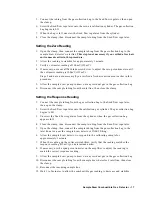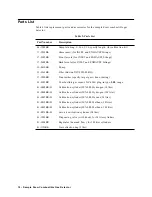
16 • Sample Draw Combustible Gas Detector
Calibration
This section describes how to calibrate the sample draw combustible gas detector. It
includes procedures to assemble the calibration kit, set the zero reading, set the response
reading, and return to normal operation.
NOTE: This procedure describes calibration using a gas collection bag. A demand flow
calibration kit is also available for calibrating the combustible gas sample draw
detector.
Preparing for Calibration
NOTE: Calibrating the sample draw adapter may cause alarms. Be sure to put the
controller into calibration mode or disable external alarms before calibrating.
1. Open the housing door.
2. Set a voltmeter to measure in the millivolt (mV) range.
3. Plug the positive lead into the transmitter test point labeled TP+; plug the negative
lead into the transmitter test point labeled TP-.
4. Use the following formula to determine the correct test points output for the
calibrating sample.
Output (mV) = (calibrating sample/fullscale) X 400 + 100
For example, with a calibrating sample of 50% LEL and a fullscale setting of 100%
LEL, the correct output is 300 mV.
300 (mV) = (50/100) X 400 +100
Assembling the Calibration Kit
1. Connect the calibration kit sample tubing along with the tubing clamp to the fitting on
the gas collection bag.
2. Connect the sample tubing from the gas collection bag to the inlet line at or near the
INLET fitting.
Allow the sample draw pump to draw out any residual gas in the gas collection bag.
NOTE: This will cause a low flow alarm when the bag is empty. Normal operation of the
sample draw adapter will resume when the tubing is disconnected from the inlet
line.
3. Disconnect the calibration kit sample tubing from the inlet line.
4. Close the clamp right away. The clamp is attached to the calibration kit sample tubing.
NOTE: If you can verify a fresh air environment, it is not necessary to use a zero air
calibration cylinder to set the zero reading. Go to the next section, “Setting the
Zero Reading.”



































